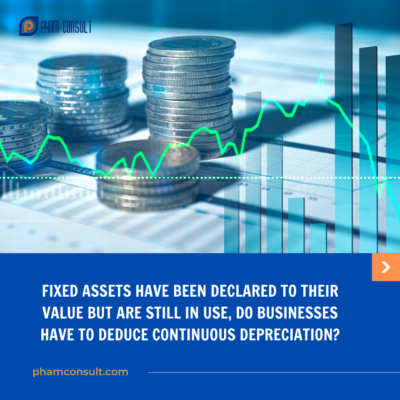If fixed assets have been fully depreciated but are still being used in production and business activities, does the enterprise have to continue depreciating them? How to handle fixed assets that have not been fully depreciated but are damaged? Through today’s article, let’s learn more about this issue with Pham Consult!

If fixed assets have been fully depreciated but are still being used in production and business activities, does the enterprise have to continue depreciating them?
Depreciation for fixed assets that have been fully depreciated is specified in Clause 1, Article 9, Circular 45/2013/TT-BTC, supplemented by Clause 4, Article 1, Circular 147/2016/TT-BTC. as follows:
Principles of depreciation of fixed assets
1. All existing fixed assets of the enterprise must be depreciated, except for the following fixed assets:
– Fixed assets have been fully depreciated but are still being used in production and business activities.
– Undepreciated fixed assets are lost.
– Other fixed assets managed by the enterprise but not owned by the enterprise (except financial lease fixed assets).
– Fixed assets are not managed, monitored, or accounted for in the enterprise’s accounting books.
– Fixed assets used in welfare activities to serve the enterprise’s employees (except for fixed assets serving employees working at the enterprise such as: mid-shift rest house, mid-shift cafeteria, changing room, etc.) toilets, clean water tanks, parking garages, medical rooms or stations for medical examination and treatment, shuttle buses for workers, training and vocational facilities, housing for workers built by the enterprise construction).
…
Comparing with the above regulations, if fixed assets have been fully depreciated but are still being used in production and business activities, the enterprise does not have to depreciate them.
How to handle fixed assets that have not been fully depreciated but are damaged?
Pursuant to Clause 4, Article 9, Circular 45/2013/TT-BTC stipulates the principles of depreciation of fixed assets as follows:
Principles of depreciation of fixed assets
…
3. In case fixed assets used in welfare activities to serve the enterprise’s employees specified in Clause 1, Article 9 of this Circular participate in production and business activities, the enterprise shall base on the time and Use the nature of these fixed assets to calculate and depreciate the business expenses of the enterprise and notify the tax authority directly managing them for monitoring and management.
4. If fixed assets that have not been fully depreciated are lost or damaged and cannot be repaired or overcome, the enterprise shall determine the cause and compensation responsibilities of the collective or individual responsible. The difference between the remaining value of the asset and the compensation paid by the organization or individual, the compensation paid by the insurance agency and the recovered value (if any), the enterprise uses the Financial Reserve Fund. to offset. In case the financial reserve fund is not enough to compensate, the difference will be included in the enterprise’s reasonable expenses when determining corporate income tax.
…
Accordingly, in cases where fixed assets have not been fully depreciated but are damaged and cannot be repaired or overcome, the enterprise shall determine the cause and compensation responsibility of the collective or individual responsible.
The difference between the remaining value of the asset and the compensation paid by the organization or individual, the compensation paid by the insurance agency and the recovered value (if any), the enterprise uses the Financial Reserve Fund. to offset.
In case the financial reserve fund is not enough to compensate, the difference will be included in the enterprise’s reasonable expenses when determining corporate income tax.
From what date does depreciation of fixed assets begin?
The time for depreciation of fixed assets is specified in Clause 9, Article 9 of Circular 45/2013/TT-BTC as follows:
Principles of depreciation of fixed assets
…
8. Enterprises with 100% state capital determine the value of the enterprise for equitization according to the discounted cash flow (DCF) method, the increase in state capital between the actual value and the recorded value is on accounting books, they are not recorded as intangible fixed assets and are gradually allocated to production and business expenses during the period but for a period not exceeding 10 years. The time to start allocating expenses is the time the enterprise officially transforms into a joint stock company (with a business registration certificate).
9. Depreciation or cancellation of depreciation of fixed assets is carried out starting from the day (according to the number of days of the month) that the fixed asset increases or decreases. Enterprises carry out accounting for increases and decreases in fixed assets according to current regulations on corporate accounting regime.
…
Thus, according to regulations, depreciation of fixed assets is carried out starting from the day (according to the number of days of the month) that the fixed asset increases or decreases.
Enterprises carry out accounting for increases and decreases in fixed assets according to current regulations on corporate accounting regime.
Comments




 VI
VI